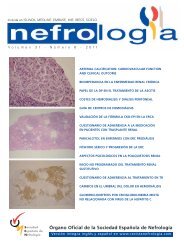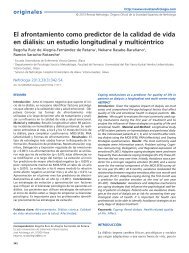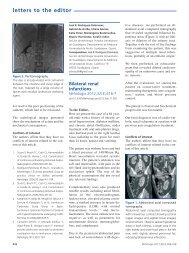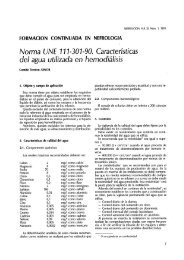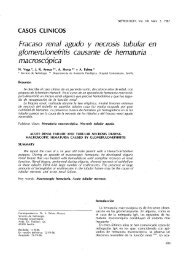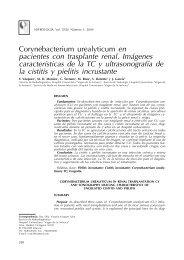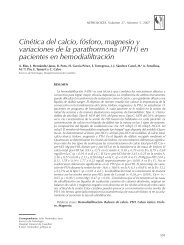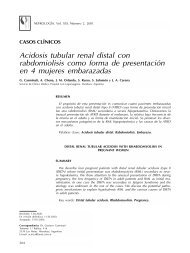PDF Número - NefrologÃa
PDF Número - NefrologÃa
PDF Número - NefrologÃa
Create successful ePaper yourself
Turn your PDF publications into a flip-book with our unique Google optimized e-Paper software.
originales<br />
Celestino Piñera-Haces et al. Tratamiento doble con calcifediol y paricalcitol<br />
Double treatment with paricalcitol-associated calcifediol<br />
and cardiovascular risk biomarkers in haemodialysis<br />
ABSTRACT<br />
Background: The deficit of 25-hydroxyvitamin D (25OHD) associated<br />
with secondary hyperparathyroidism (SHPT) are frequent<br />
findings in patients with chronic kidney disease (CKD)<br />
on hemodialysis (HD). These events are associated with increased<br />
morbidity and mortality of cardiovascular (CV).<br />
25OHD adequate serum levels as well as the use of selective<br />
activators of the vitamin D receptor (AsRVD) have been shown<br />
to have beneficial effects on bone metabolism and mineral<br />
and cardiovascular risk independently. Currently there is still<br />
controversy regarding the type of supplementation needed<br />
by patients with CKD on HD. Aims: The aim of our study was<br />
to evaluate whether there is benefit in combination therapy<br />
with 25OHD, calcifediol and a AsRVD, oral paricalcitol on<br />
bone-mineral metabolism and inflammatory markers, compared<br />
to single treatment with each of them in a group HD<br />
patients. Material and methods: A prospective study of 6<br />
months, over 26 patients in our HD unit. We randomized patients<br />
into two groups: group 1 (G1) received oral paricalcitol<br />
treatment at doses of 1mcg/day. Group 2 (G2) was treated<br />
with 1 ampoule calcifediol/wk (0.266mg/wk=16.000U) orally.<br />
After 3 months of treatment, was added to the G1 and G2 calcifediol<br />
and paricalcitol respectively at the same doses, keeping<br />
these treatments together for 3 months to complete the<br />
6 months follow up. Laboratory tests were performed at<br />
months 0, 3 and 6, measuring in all patients serum markers of<br />
25OHD, calcium (Ca), phosphorus (P) and PTH Bone turnover<br />
markers were: alkaline phosphatase (FA), aminoterminal<br />
propeptide of procollagen type 1 (Pinp1) and carboxyl-terminal<br />
telopeptide of type I collagen (CrossLaps) and inflammatory<br />
markers : IL-8. WE also collected data on levels of insulin,<br />
glucose, hemoglobin, erythropoietic agents (ESAs) and rates<br />
of resistance to EPO and HOMA (homeostasis model assessment).<br />
Results: We detected a deficit of 25-hydroxyvitamin<br />
D in all patients studied, with a mean of 13.67±4.81ng/ml.<br />
Supplementation with oral calcifediol significantly corrects<br />
this deficit without evidence of toxicity (35.36±33.68ng/ml in<br />
G1 at 6 months and 59.21±26.50ng/ml in G2 at 3 months). Paricalcitol<br />
treatment significantly reduces PTH levels in G1 at 3<br />
months (P



